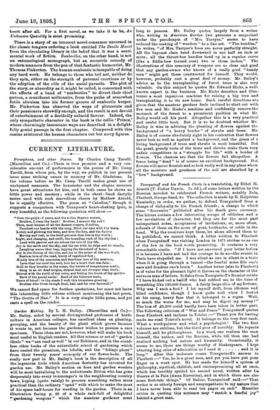Garden Making. By L. H. Bailey. (Macmillan and Co.)— Mr.
Bailey, aided by several distinguished professors of horti- culture in American colleges, has excellent ideas on planting, grouping, and the beauty of the plant which grows because it wants to, not because the gardener wishes to possess a rare specimen. These ideas are not, however, what will make his book most useful to English readers. All this science or art of " garden ideals " we "can read as well" in our Robinson, and in the count- less other books of the naturalistic school of gardening which have ousted the geranium, the lobelia, and the " foliage plant " from their twenty years' monopoly of our flower-beds. The meetly new part in Mr. Bailey's book is the description cf all the ingenious tools which American dexterity has invented for garden use. Mr. Bailey's section on hoes and garden weeders will be most tantalising to the unfortunate Briton who has gone desperately into every ironmonger's in the neighbouring country -town. hoping (quite vainly) to procure something rather more practical than the ordinary " spud" with which to make the most of his spare half-hours for weeding in the garden. There is an illustration facing p. 26 of a whole rack-full of delightful "" gardening weapons " which the amateur gardener must long to possess. Mr. Bailey quotes largely from a writer who, writing in American Garden (we presume a magazine) under the pseudonym of " Mrs. Tarryer," seems to have reduced the making of " weeders " to a fine art. " The handles," he writes, " of Mrs. Tarryer's hoes are never perfectly straight. All the bayonet class bend downward in use half an inch or more ; all the thrust-hoe handles bend up in a regular curve (like a fiddle-bow turned over) two or three inches." The illustrations of this armoury of weapons are so clear and good that any garden-owner who knows of a really good " handy man " might get them constructed for himself. They would, however, probably cost a great deal of money. Mr. Bailey's advice as to the transplanting of forest trees is also very valuable. On this subject he quotes Mr. Edward Hicks, a well- known expert in the business. Mr. Hicks describes and illus- trates a most ingenious machine for raising a big tree and transplanting it to its new home. Such careful directions aro given that the amateur gardner feels inclined to start out with five men and Mr. Hisks's machine and confidently remove the monarch of the forest to a prominent position in what Mr Bailey would call his yard. Altogether this is a very practical and useful little book. But it is to be doubted whether Mr. Bailey is wise in advising the planting of flowers against the background of "a heavy border" of shrubs and trees. Mr. Bailey is of course absolutely right in his contention that flowers never look so well as against a background, and the green of a living background of trees and shrubs is most beautiful. But the great, greedy roots of the trees and shrubs make them very unfair competitors in a " struggle for life" with a border of flowers. The chances are that the flowers fail altogether. A fence being " dead " is of course an excellent background. But flowers will never flourish and so look really well in any place where all the moisture and goodness of the soil are absorbed by a "live" background.


































 Previous page
Previous page